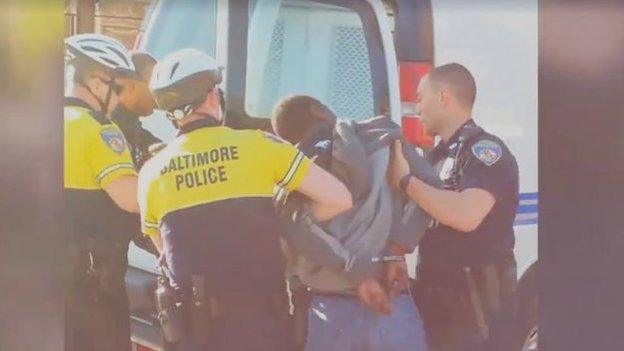Baltimore police death: How did Freddie Gray die?
- Published

A still from amateur video footage of Freddie Gray being handcuffed and pushed into a police van
Sometime between being stopped by police in the rough Baltimore neighbourhood of Sandtown-Winchester and arriving at the city's western district police station in a van, Freddie Gray sustained an injury that killed him.
He fell into a coma first, succumbing to his injuries in hospital a week later.
We know that he suffered a severe spinal injury to his neck, but how that injury happened remains a mystery.
There has been a suggestion he intentionally injured himself - but a leading spinal surgeon told the BBC that would be "impossible".
Gray also reportedly suffered severe head injuries while in the police van, but the police have not confirmed the reports.
And he complained of having trouble breathing, which a surgeon said could be related to a neck injury sustained during arrest.
So what did kill Freddie Gray?
The arrest
Gray's arrest was caught on film by a bystander, Kevin Young. Mr Young's video shows Gray being held face down on the pavement by two officers with him arms handcuffed behind him and his feet bent up to his back.
"He was folded up like a crab, or a piece of origami. He was all bent up," Mr Young said.
Gray is heard crying out in pain as the officers first restrain him then pick him up and drag him towards the van. His body appears limp, but he is still crying out.
Arun Ranganathan, a consultant trauma and spinal surgeon at St. Bart's Hospital, told the BBC it is possible that Gray sustained his spinal injury during his arrest.
Mr Ranganathan said that his spinal cord could have been fractured and remained aligned, allowing Gray to maintain consciousness and move but slowly exerting a pressure on his vertebral artery.
"If there was pressure on the spinal cord then it's possible he could have become paralysed or suffered a stroke in the van," he said.
But it would be very unlikely to kill him, Mr Ranganathan said. "It could only kill if the injury is higher up at the base of the skull, where it could exert pressure on the respiratory systems, preventing the person being able to breathe."
Police have said that Gray complained of trouble breathing and asked for his inhaler but was denied it.
A 'nickel ride'
Police have admitted that Gray was not secured in the van while it was moving, against department protocol. The revelation led many to speculate about whether he had been subjected to a so-called "nickel ride" - a police tactic of leaving a suspect unsecured in a van during an intentionally rough journey.
Citing police sources, Washington TV station WJLA said Gray died when his head violently struck a bolt inside the van. And the Washington Post reported that Gray had suffered injuries consistent with a car crash.
We know that Gray fell unconscious during the journey.
A violent impact even within a confined space could have caused a brain haemorrhage, Mr Ranganathan said.
"Unconsciousness is usually related to a head injury, rather than a spinal injury," he said.
He 'injured himself'
We know that the van made a stop en route to the police station to pick up a second prisoner.
Citing to a report it obtained from the Baltimore police, the Washington Post reported that the second prisoner said Gray was "banging against the walls" and was "intentionally trying to injure himself".
But Mr Ranganathan said it was highly unlikely Gray could have inflicted his spinal injury on himself.
"For someone to break their own spine is very difficult, impossible," Mr Ranganathan said.
"Usually it is a high-velocity injury, for example if they hang themselves or have a high impact tackle in rugby.
"But no, for someone to break his neck in a confined space like that is almost impossible.
Mr Ranganathan said it was more like that Gray's spine was injured during his arrest, and the force of being pushed in the van or thrown around inside exacerbated the injury.
"In my opinion, his spine was injured before he got in that van," he said.